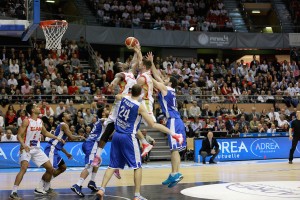Blackmagic Design scores a slam dunk with DeckLink
 Graphics play a significant role in sports broadcasting, with viewers demanding a vast amount of accurate information at a single glance. As well as scores and time remaining, statistics on player performance, 2D and 3D animations of match statistics can be instantly projected on a screen to give fans everything they need to understand and assess the game. However, with increased complexity in graphics creation and delivery come higher costs and sports with an international reach face a challenge in finding solutions that are not only cost-effective but also standardize how we use the data across all of our broadcasts.
Graphics play a significant role in sports broadcasting, with viewers demanding a vast amount of accurate information at a single glance. As well as scores and time remaining, statistics on player performance, 2D and 3D animations of match statistics can be instantly projected on a screen to give fans everything they need to understand and assess the game. However, with increased complexity in graphics creation and delivery come higher costs and sports with an international reach face a challenge in finding solutions that are not only cost-effective but also standardize how we use the data across all of our broadcasts.
FIBA Europe, the Regional Office of FIBA, International Basketball Federation, faced this exact challenge. “We previously gave TV broadcasters and producers access to a central database of statistics and player information, graphic elements such as 3D models, fonts, and backgrounds together with official guidelines,” explains Nick Mazoli, FIBA.
“But to produce the graphics to a professional level, the systems broadcasters were using were high cost, so there was a huge disparity in production quality, for example, our top events like EuroBasket and smaller one’s such European youth championships. We needed to be able to produce the same look and feel for up to 200 matches a year, in all localities, regardless of budgets.”
FIBA decided to develop a centralised system which combined customized software together with Blackmagic capture and playback hardware, which could then be given to partners and broadcasters for graphics production. The software pulls information from the FIBA database, official match statistics via the arena LAN, and scoreboard data through the serial communication interface at the venue. The data is loaded into predefined templates to create the onscreen graphics and animations. Broadcasters can then use either a PC, equipped with a DeckLink 4K Extreme, or for a more compact Thunderbolt-equipped notebook and UltraStudio 4K to provide a live signal directly to the OB van.
Danilo Lukic from Blackmagic OEM ELEGRA explains why the use of DeckLink I/O cards was essential. “We needed I/O cards that were capable of supporting all broadcast video formats, from analog up to HD, 16:9 and 4:3, as well as all video standards, including PAL/NTSC and 50i/59. Another key advantage was the SDK and third party libraries that Blackmagic makes freely available, which made integration with our software incredibly smooth and allowed us to create a completely customized solution.”
“We had to achieve a balance between flexibility of production values and a standardised, professional graphics solution, while keeping the solution affordable so that all levels of the sport could use it,” concludes Nick. “The Blackmagic Design capture hardware is integral to the reliability and quality of the system and ensures that all of the official data that FIBA stipulates is broadcast to viewers across the world, no matter where they are watching.”

